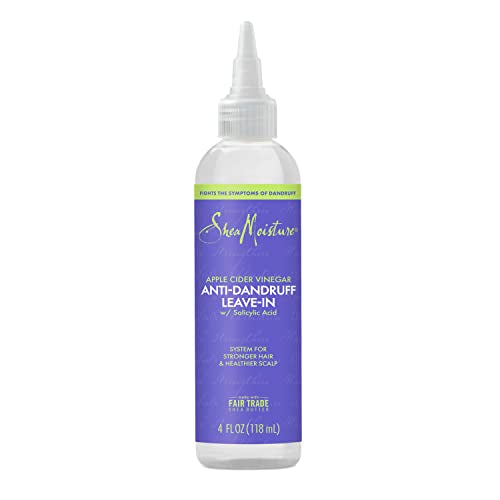
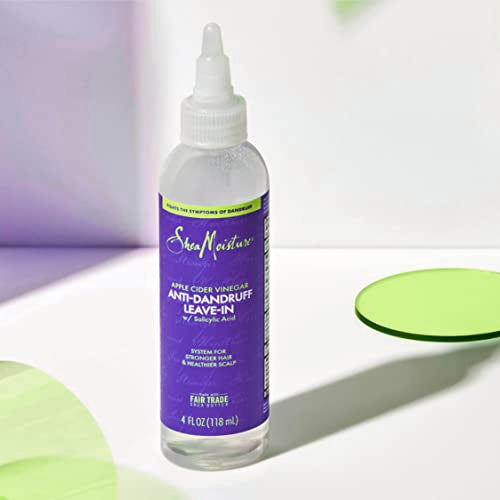
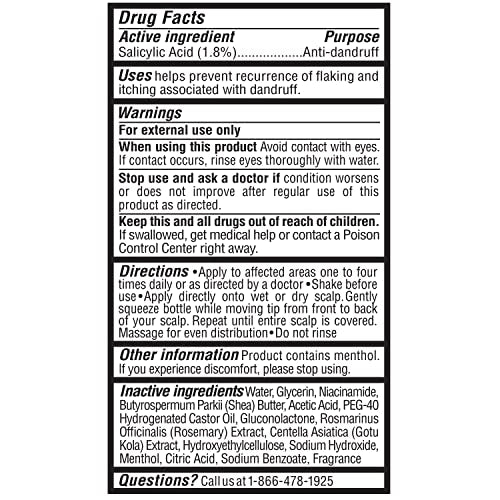
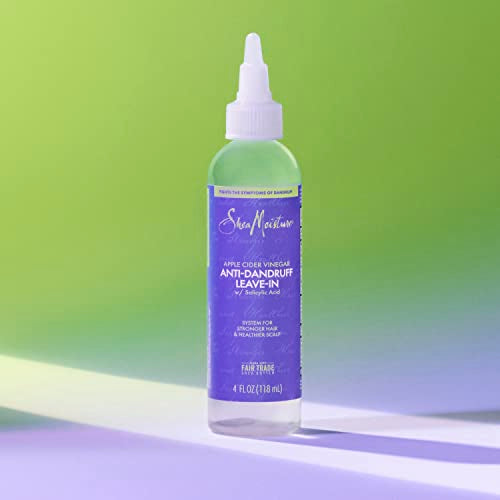
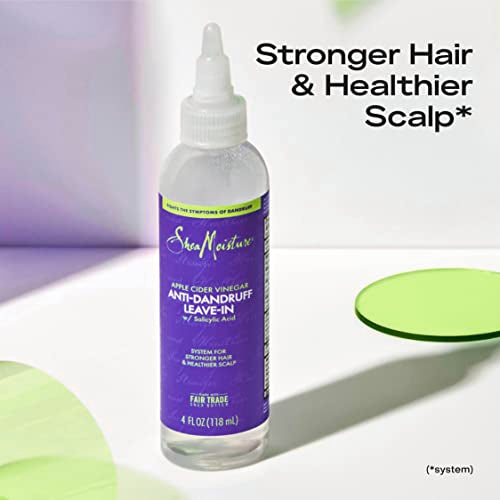
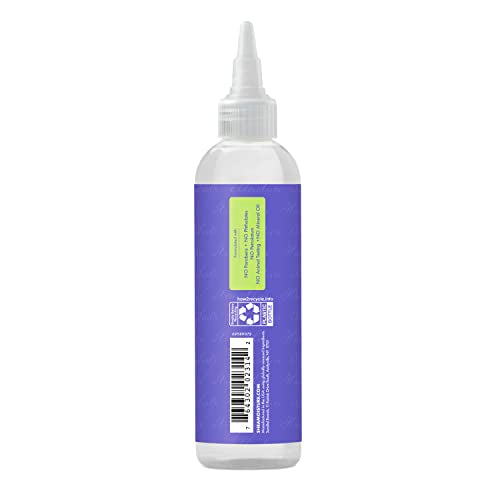
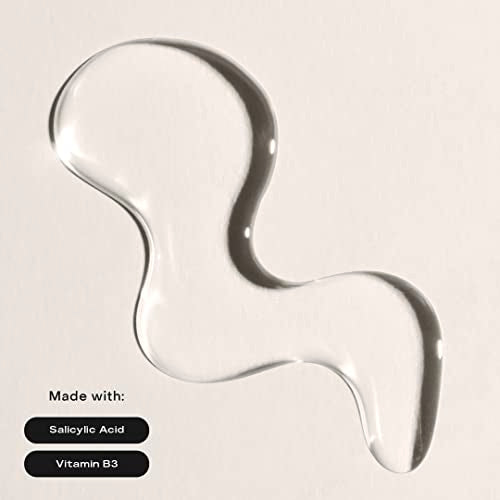
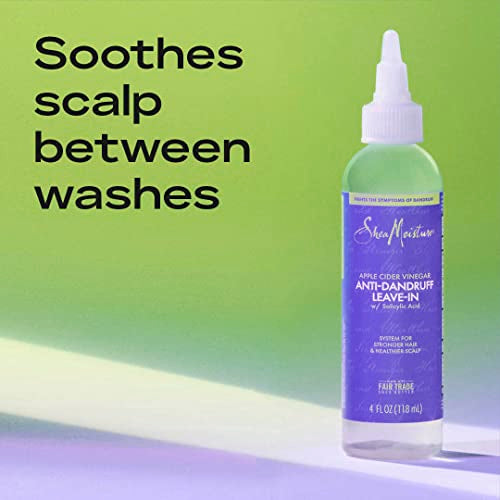
SheaMoisture Anti-Dandruff Leave-In Conditioner - Soothes Scalp, Strengthens Hair - 4oz


Fragrance
High RiskFragrance refers to a mixture of aromatic compounds used in products to provide scent. It is commonly listed as 'fragrance' or 'parfum' on product labels and can serve various functions, including enhancing user experience and masking undesirable odors.
Sustai Insights
Fragrance offers functional benefits by improving product appeal; however, it poses significant health risks, notably a high likelihood of causing allergies and allergic contact dermatitis. Environmental risks include potential pollution and endocrine disruption, though its overall carcinogenicity is low. Regulatory bodies have noted concerns regarding its use, leading to a high-risk classification. Safe usage practices should be observed, and alternatives such as natural essential oils are recommended for those sensitive to synthetic fragrances.
Sodium Hydroxide
High RiskSodium hydroxide is a highly caustic and reactive inorganic compound commonly used as a pH adjuster in various products. It is effective in neutralizing acids and plays a role in the production of soaps and detergents.
Sustai Insights
Sodium hydroxide serves essential functions, particularly in adjusting pH levels, but poses significant health risks, including skin and eye irritation. It is subject to high usage restrictions due to its corrosive nature. Environmental concerns include its potential to pollute water sources and contribute to ecosystem damage. Regulatory bodies have imposed strict guidelines on its use, indicating a high-risk profile for products containing this ingredient. Safe handling practices are crucial, and alternatives include milder pH adjusters, emphasizing the need for caution in its application.
Sodium Benzoate
Medium RiskSodium benzoate is a preservative commonly used in food and cosmetic products to prevent microbial growth and extend shelf life. It is derived from benzoic acid and is effective at low concentrations, often used in acidic environments like beverages and condiments.
Sustai Insights
Sodium benzoate serves effectively as a preservative, contributing to product stability and safety. It is generally recognized as safe with low concerns for carcinogenicity, allergies, and reproductive toxicity, though it faces moderate use restrictions in some regions. Environmental risks include its potential as a pollutant, but it does not bioaccumulate significantly. Regulatory bodies have issued advisories regarding its concentration in products. Overall, the risk level is assessed as medium, with safe usage practices recommended. Alternatives such as potassium sorbate may provide similar benefits with potentially lower restrictions.
Rosmarinus Officinalis (Rosemary) Leaf Extract
Medium RiskRosemary leaf extract is produced from the leaves of the Rosmarinus officinalis plant. It is commonly used in cosmetic formulations for its potential antioxidant properties and fragrance. The extract may also contribute to the preservation of products due to its antimicrobial characteristics.
Sustai Insights
Rosemary leaf extract offers functional benefits such as antioxidant and antimicrobial properties, which can enhance product stability and shelf-life. It is generally considered low risk for carcinogenicity and reproductive toxicity, but it carries a moderate potential for allergic reactions. Environmentally, it poses low risk with no significant pollutant or bioaccumulation concerns. Regulatory bodies have not placed significant restrictions on its use, although some verified products cannot contain certain concentrations. Overall, the ingredient's risk level is medium, necessitating careful usage practices to mitigate allergic responses.
Citric Acid
Medium RiskCitric acid is an alpha hydroxy acid used in personal care products primarily for its role as a pH adjuster and natural preservative. It occurs naturally in citrus fruits and is commonly utilized in various formulations for its chelating properties and mild exfoliation benefits.
Sustai Insights
Citric acid offers functional benefits as an effective preservative and pH stabilizer, contributing to product longevity and stability. It is biodegradable and derived from renewable sources. Health risks are low, with minimal concerns regarding carcinogenicity, allergies, and reproductive toxicity. However, moderate use restrictions exist due to potential irritation at high concentrations. Environmental risks are limited, as citric acid is not known to accumulate in ecosystems. Regulatory agencies have no significant advisories against its use. Overall, it is assessed as a medium-risk ingredient, with safe usage practices recommended and alternatives available.
Acetum
Low RiskAcetum, commonly known as vinegar, is a solution of acetic acid in water. It is often used in food preservation, flavoring, and culinary applications. Acetum functions as a natural preservative and can aid in food safety by inhibiting the growth of certain bacteria.
Sustai Insights
Acetum offers functional benefits as a preservative and flavoring agent, while being biodegradable and derived from renewable sources. Health risks are low, with minimal concerns regarding carcinogenicity, allergies, or reproductive toxicity. Environmental risks are negligible, as it does not contribute significantly to pollution or bioaccumulation. Regulatory assessments indicate no current restrictions. Overall, its risk level is low, making it a safe choice for use in various applications.
Butyrospermum Parkii (Shea) Butter
Low RiskButyrospermum parkii (shea) butter is a vegetable fat derived from the nuts of the shea tree. It is commonly used in cosmetic formulations for its emollient properties, providing moisture and improving skin texture. Additionally, shea butter is known for its ability to enhance the stability of products and deliver a creamy texture.
Sustai Insights
Shea butter offers functional benefits as an effective moisturizer, enhancing skin barrier function and texture. It is sustainably sourced and biodegradable, contributing to eco-friendliness. Health-wise, it is associated with low risks for carcinogenicity, allergies, and reproductive toxicity. Environmental impacts are minimal, with no significant pollutant potential identified. Regulatory assessments indicate no current restrictions. Overall, the ingredient presents a low risk, making it a favorable choice in cosmetic formulations.
Hydroxyethylcellulose
Low RiskHydroxyethylcellulose is a modified cellulose polymer used primarily as a thickening agent and stabilizer in various cosmetic and personal care products. It is soluble in water and helps to improve the texture and viscosity of formulations, enhancing their usability and performance.
Sustai Insights
Hydroxyethylcellulose offers functional benefits such as effective thickening and stabilization in formulations, contributing to product texture. It is generally considered low-risk in terms of health, with minimal concerns regarding carcinogenicity, allergens, or reproductive toxicity. Environmentally, it poses low risks and is not known to be bioaccumulative. Regulatory bodies have not imposed significant restrictions on its use. Safe practices include adhering to recommended concentrations, and while alternatives exist, hydroxyethylcellulose remains a low-risk ingredient overall.
Water
Low RiskWater is a clear, colorless liquid essential for various biological processes. It serves as a solvent in formulations, facilitating the dissolution of other ingredients and enhancing product texture and application. Additionally, water plays a crucial role in hydration and is a key component in many cosmetic and personal care products.
Sustai Insights
Water is an effective solvent and hydrator, contributing to the texture and efficacy of formulations. It is biodegradable and generally regarded as safe, with low concerns regarding carcinogenicity, allergies, and reproductive toxicity. However, excessive water usage can lead to environmental concerns, particularly regarding resource depletion. Regulatory bodies do not impose restrictions on water use in cosmetics. Overall, the risks associated with water are low, making it a safe and essential ingredient.
Neomenthol
Low RiskNeomenthol is a menthol derivative commonly used for its cooling sensation in cosmetic and topical formulations. It acts primarily as a fragrance component and a soothing agent, contributing to the sensory attributes of products such as creams and ointments.
Sustai Insights
Neomenthol offers functional benefits, including its cooling effect and soothing properties in topical applications. It is not associated with significant health risks, as concerns regarding carcinogenicity, allergies, and toxicity are low. Environmentally, it poses minimal risks and is not classified as a pollutant. Regulatory status indicates no current restrictions. Overall, its risk level is assessed as low, making it a safe option for use in personal care products.
Gluconolactone
Low RiskGluconolactone is a lactone that functions primarily as a humectant and exfoliant in cosmetic products. It is derived from gluconic acid and is used to improve skin hydration and texture. This ingredient is known for its compatibility with various skin types and its ability to enhance product stability.
Sustai Insights
Gluconolactone offers functional benefits as an effective humectant, promoting skin hydration and serving as a gentle exfoliant. It is biodegradable and has low allergenic potential. Health risks are minimal, with low concerns for carcinogenicity, immunotoxicity, and reproductive toxicity. Environmental risks are also low, with no known pollutant or bioaccumulative effects. Regulatory bodies, including the FDA, have not imposed restrictions on its use. Overall, the risk level associated with gluconolactone is low, making it a safe choice in cosmetic formulations.
Peg 40 Hydrogenated Castor Oil
Low RiskPEG-40 hydrogenated castor oil is a polyethylene glycol derivative of hydrogenated castor oil, commonly used as an emulsifier and surfactant in various cosmetic and personal care products. It helps to improve the texture and stability of formulations by facilitating the blending of oil and water-based ingredients.
Sustai Insights
PEG-40 hydrogenated castor oil offers functional benefits such as effective emulsification and stability enhancement in formulations. It is considered low risk for health concerns, including carcinogenicity and allergenic potential. Environmentally, it is not associated with significant hazards, and regulatory bodies have not imposed strict restrictions. Safe usage practices involve adhering to recommended concentrations. Overall, this ingredient presents a low risk profile with limited environmental impact, making it a suitable choice in cosmetic applications.
Niacinamide
Low RiskNiacinamide, also known as nicotinamide, is a form of vitamin B3 (niacin) that serves various functions in skincare and cosmetic products. It is often used for its potential benefits in improving skin texture, enhancing moisture retention, and supporting the skin's barrier function.
Sustai Insights
Niacinamide provides functional benefits such as enhancing skin hydration and improving the appearance of uneven skin tone. It is generally recognized as safe, with low concerns regarding carcinogenicity, allergies, or reproductive toxicity. However, enhanced skin absorption may pose risks for sensitive individuals. Regulatory bodies impose few restrictions on its use, and it is considered low risk overall. For safer alternatives, options like panthenol may be considered. Overall, niacinamide is a low-risk ingredient when used appropriately.
Vegetarian Glycerin
Low RiskVegetarian glycerin, also known as glycerol, is a colorless, odorless, and viscous liquid derived from plant sources. It is primarily used as a humectant, solvent, and emollient in various personal care products, helping to retain moisture and improve texture.
Sustai Insights
Vegetarian glycerin offers functional benefits as an effective humectant, promoting hydration and skin smoothness. It is biodegradable and typically sustainably sourced. Health risks associated with glycerin are low, with no significant concerns for carcinogenicity, allergens, or reproductive toxicity. Environmental risks are minimal, and it is not subject to major regulatory warnings. Overall, the risk level for this ingredient is low, making it a safe choice in formulations. Safe usage practices include ensuring proper concentrations in products, and alternatives such as propylene glycol exist but may have differing properties.
Acetum
Low RiskAcetum, commonly known as vinegar, is a solution of acetic acid in water. It is often used in food preservation, flavoring, and culinary applications. Acetum functions as a natural preservative and can aid in food safety by inhibiting the growth of certain bacteria.
Sustai Insights
Acetum offers functional benefits as a preservative and flavoring agent, while being biodegradable and derived from renewable sources. Health risks are low, with minimal concerns regarding carcinogenicity, allergies, or reproductive toxicity. Environmental risks are negligible, as it does not contribute significantly to pollution or bioaccumulation. Regulatory assessments indicate no current restrictions. Overall, its risk level is low, making it a safe choice for use in various applications.
Fragrance
High RiskFragrance refers to a mixture of aromatic compounds used in products to provide scent. It is commonly listed as 'fragrance' or 'parfum' on product labels and can serve various functions, including enhancing user experience and masking undesirable odors.
Sustai Insights
Fragrance offers functional benefits by improving product appeal; however, it poses significant health risks, notably a high likelihood of causing allergies and allergic contact dermatitis. Environmental risks include potential pollution and endocrine disruption, though its overall carcinogenicity is low. Regulatory bodies have noted concerns regarding its use, leading to a high-risk classification. Safe usage practices should be observed, and alternatives such as natural essential oils are recommended for those sensitive to synthetic fragrances.
Sodium Hydroxide
High RiskSodium hydroxide is a highly caustic and reactive inorganic compound commonly used as a pH adjuster in various products. It is effective in neutralizing acids and plays a role in the production of soaps and detergents.
Sustai Insights
Sodium hydroxide serves essential functions, particularly in adjusting pH levels, but poses significant health risks, including skin and eye irritation. It is subject to high usage restrictions due to its corrosive nature. Environmental concerns include its potential to pollute water sources and contribute to ecosystem damage. Regulatory bodies have imposed strict guidelines on its use, indicating a high-risk profile for products containing this ingredient. Safe handling practices are crucial, and alternatives include milder pH adjusters, emphasizing the need for caution in its application.
Butyrospermum Parkii (Shea) Butter
Low RiskButyrospermum parkii (shea) butter is a vegetable fat derived from the nuts of the shea tree. It is commonly used in cosmetic formulations for its emollient properties, providing moisture and improving skin texture. Additionally, shea butter is known for its ability to enhance the stability of products and deliver a creamy texture.
Sustai Insights
Shea butter offers functional benefits as an effective moisturizer, enhancing skin barrier function and texture. It is sustainably sourced and biodegradable, contributing to eco-friendliness. Health-wise, it is associated with low risks for carcinogenicity, allergies, and reproductive toxicity. Environmental impacts are minimal, with no significant pollutant potential identified. Regulatory assessments indicate no current restrictions. Overall, the ingredient presents a low risk, making it a favorable choice in cosmetic formulations.
Hydroxyethylcellulose
Low RiskHydroxyethylcellulose is a modified cellulose polymer used primarily as a thickening agent and stabilizer in various cosmetic and personal care products. It is soluble in water and helps to improve the texture and viscosity of formulations, enhancing their usability and performance.
Sustai Insights
Hydroxyethylcellulose offers functional benefits such as effective thickening and stabilization in formulations, contributing to product texture. It is generally considered low-risk in terms of health, with minimal concerns regarding carcinogenicity, allergens, or reproductive toxicity. Environmentally, it poses low risks and is not known to be bioaccumulative. Regulatory bodies have not imposed significant restrictions on its use. Safe practices include adhering to recommended concentrations, and while alternatives exist, hydroxyethylcellulose remains a low-risk ingredient overall.
Water
Low RiskWater is a clear, colorless liquid essential for various biological processes. It serves as a solvent in formulations, facilitating the dissolution of other ingredients and enhancing product texture and application. Additionally, water plays a crucial role in hydration and is a key component in many cosmetic and personal care products.
Sustai Insights
Water is an effective solvent and hydrator, contributing to the texture and efficacy of formulations. It is biodegradable and generally regarded as safe, with low concerns regarding carcinogenicity, allergies, and reproductive toxicity. However, excessive water usage can lead to environmental concerns, particularly regarding resource depletion. Regulatory bodies do not impose restrictions on water use in cosmetics. Overall, the risks associated with water are low, making it a safe and essential ingredient.
Neomenthol
Low RiskNeomenthol is a menthol derivative commonly used for its cooling sensation in cosmetic and topical formulations. It acts primarily as a fragrance component and a soothing agent, contributing to the sensory attributes of products such as creams and ointments.
Sustai Insights
Neomenthol offers functional benefits, including its cooling effect and soothing properties in topical applications. It is not associated with significant health risks, as concerns regarding carcinogenicity, allergies, and toxicity are low. Environmentally, it poses minimal risks and is not classified as a pollutant. Regulatory status indicates no current restrictions. Overall, its risk level is assessed as low, making it a safe option for use in personal care products.
Sodium Benzoate
Medium RiskSodium benzoate is a preservative commonly used in food and cosmetic products to prevent microbial growth and extend shelf life. It is derived from benzoic acid and is effective at low concentrations, often used in acidic environments like beverages and condiments.
Sustai Insights
Sodium benzoate serves effectively as a preservative, contributing to product stability and safety. It is generally recognized as safe with low concerns for carcinogenicity, allergies, and reproductive toxicity, though it faces moderate use restrictions in some regions. Environmental risks include its potential as a pollutant, but it does not bioaccumulate significantly. Regulatory bodies have issued advisories regarding its concentration in products. Overall, the risk level is assessed as medium, with safe usage practices recommended. Alternatives such as potassium sorbate may provide similar benefits with potentially lower restrictions.
Rosmarinus Officinalis (Rosemary) Leaf Extract
Medium RiskRosemary leaf extract is produced from the leaves of the Rosmarinus officinalis plant. It is commonly used in cosmetic formulations for its potential antioxidant properties and fragrance. The extract may also contribute to the preservation of products due to its antimicrobial characteristics.
Sustai Insights
Rosemary leaf extract offers functional benefits such as antioxidant and antimicrobial properties, which can enhance product stability and shelf-life. It is generally considered low risk for carcinogenicity and reproductive toxicity, but it carries a moderate potential for allergic reactions. Environmentally, it poses low risk with no significant pollutant or bioaccumulation concerns. Regulatory bodies have not placed significant restrictions on its use, although some verified products cannot contain certain concentrations. Overall, the ingredient's risk level is medium, necessitating careful usage practices to mitigate allergic responses.
Citric Acid
Medium RiskCitric acid is an alpha hydroxy acid used in personal care products primarily for its role as a pH adjuster and natural preservative. It occurs naturally in citrus fruits and is commonly utilized in various formulations for its chelating properties and mild exfoliation benefits.
Sustai Insights
Citric acid offers functional benefits as an effective preservative and pH stabilizer, contributing to product longevity and stability. It is biodegradable and derived from renewable sources. Health risks are low, with minimal concerns regarding carcinogenicity, allergies, and reproductive toxicity. However, moderate use restrictions exist due to potential irritation at high concentrations. Environmental risks are limited, as citric acid is not known to accumulate in ecosystems. Regulatory agencies have no significant advisories against its use. Overall, it is assessed as a medium-risk ingredient, with safe usage practices recommended and alternatives available.
Gluconolactone
Low RiskGluconolactone is a lactone that functions primarily as a humectant and exfoliant in cosmetic products. It is derived from gluconic acid and is used to improve skin hydration and texture. This ingredient is known for its compatibility with various skin types and its ability to enhance product stability.
Sustai Insights
Gluconolactone offers functional benefits as an effective humectant, promoting skin hydration and serving as a gentle exfoliant. It is biodegradable and has low allergenic potential. Health risks are minimal, with low concerns for carcinogenicity, immunotoxicity, and reproductive toxicity. Environmental risks are also low, with no known pollutant or bioaccumulative effects. Regulatory bodies, including the FDA, have not imposed restrictions on its use. Overall, the risk level associated with gluconolactone is low, making it a safe choice in cosmetic formulations.
Peg 40 Hydrogenated Castor Oil
Low RiskPEG-40 hydrogenated castor oil is a polyethylene glycol derivative of hydrogenated castor oil, commonly used as an emulsifier and surfactant in various cosmetic and personal care products. It helps to improve the texture and stability of formulations by facilitating the blending of oil and water-based ingredients.
Sustai Insights
PEG-40 hydrogenated castor oil offers functional benefits such as effective emulsification and stability enhancement in formulations. It is considered low risk for health concerns, including carcinogenicity and allergenic potential. Environmentally, it is not associated with significant hazards, and regulatory bodies have not imposed strict restrictions. Safe usage practices involve adhering to recommended concentrations. Overall, this ingredient presents a low risk profile with limited environmental impact, making it a suitable choice in cosmetic applications.
Niacinamide
Low RiskNiacinamide, also known as nicotinamide, is a form of vitamin B3 (niacin) that serves various functions in skincare and cosmetic products. It is often used for its potential benefits in improving skin texture, enhancing moisture retention, and supporting the skin's barrier function.
Sustai Insights
Niacinamide provides functional benefits such as enhancing skin hydration and improving the appearance of uneven skin tone. It is generally recognized as safe, with low concerns regarding carcinogenicity, allergies, or reproductive toxicity. However, enhanced skin absorption may pose risks for sensitive individuals. Regulatory bodies impose few restrictions on its use, and it is considered low risk overall. For safer alternatives, options like panthenol may be considered. Overall, niacinamide is a low-risk ingredient when used appropriately.
Vegetarian Glycerin
Low RiskVegetarian glycerin, also known as glycerol, is a colorless, odorless, and viscous liquid derived from plant sources. It is primarily used as a humectant, solvent, and emollient in various personal care products, helping to retain moisture and improve texture.
Sustai Insights
Vegetarian glycerin offers functional benefits as an effective humectant, promoting hydration and skin smoothness. It is biodegradable and typically sustainably sourced. Health risks associated with glycerin are low, with no significant concerns for carcinogenicity, allergens, or reproductive toxicity. Environmental risks are minimal, and it is not subject to major regulatory warnings. Overall, the risk level for this ingredient is low, making it a safe choice in formulations. Safe usage practices include ensuring proper concentrations in products, and alternatives such as propylene glycol exist but may have differing properties.
Experience healthier scalp days with SheaMoisture's Anti-Dandruff Leave-In Conditioner, expertly crafted with Apple Cider Vinegar and Fair Trade Shea Butter. This nourishing treatment not only soothes irritation but also strengthens hair for enhanced resilience.
- Soothing Relief: Infused with Apple Cider Vinegar and Salicylic Acid, this leave-in conditioner alleviates flaking and itching, providing instant comfort to your scalp.
- Nourishing Ingredients: Enriched with Vitamin B3 and Fair Trade Shea Butter, it promotes a balanced scalp microbiome while delivering essential moisture to your hair.
- Ethically Produced: Crafted with care, this product is cruelty-free, sustainably produced, and contains no parabens, phthalates, or mineral oils.
- User-Friendly Application: Designed for easy use on clean, damp hair—simply apply and style without rinsing!
- Daily Defense: Incorporate this leave-in treatment into your routine for ongoing protection against dandruff and to maintain scalp health.
Elevate your hair care ritual with a product that prioritizes both your well-being and the planet.
Subscribe & Save with Sustai
- Best Price Guarantee: Always enjoy the lowest prices on sustainable home essentials.
- No Surprises: We’ll notify you before shipping. No hidden fees, ever.
- You’re in Charge: Change, pause, or cancel your subscription anytime with ease.
- Eco-Friendly Deliveries: Our grouped shipments mean less packaging and lower emissions.
Join us on a sustainable journey. Special offers for a limited time! Prices and promotions may change.
Recommended Products
Experience healthier scalp days with SheaMoisture's Anti-Dandruff Leave-In Conditioner, expertly crafted with Apple Cider Vinegar and Fair Trade Shea Butter. This nourishing treatment not only soothes irritation but also strengthens hair for enhanced resilience.
- Soothing Relief: Infused with Apple Cider Vinegar and Salicylic Acid, this leave-in conditioner alleviates flaking and itching, providing instant comfort to your scalp.
- Nourishing Ingredients: Enriched with Vitamin B3 and Fair Trade Shea Butter, it promotes a balanced scalp microbiome while delivering essential moisture to your hair.
- Ethically Produced: Crafted with care, this product is cruelty-free, sustainably produced, and contains no parabens, phthalates, or mineral oils.
- User-Friendly Application: Designed for easy use on clean, damp hair—simply apply and style without rinsing!
- Daily Defense: Incorporate this leave-in treatment into your routine for ongoing protection against dandruff and to maintain scalp health.
Elevate your hair care ritual with a product that prioritizes both your well-being and the planet.

You can have at most 2 Sustainable Steals products in your cart
Customer Reviews
Customers’ View
Customers appreciate the effectiveness and gentle formulation of the SheaMoisture Anti-Dandruff Leave-In Conditioner. Many users note significant improvements in scalp condition, with one customer reporting an 80% reduction in flakes after just one application. The product's soothing formula, enriched with Apple Cider Vinegar and Fair Trade Shea Butter, is often highlighted for its nourishing properties while being free from harsh chemicals like parabens and phthalates. Additionally, several reviews commend its pleasant scent and non-greasy texture, making it suitable for daily use. Overall, customers find this product to be a reliable option for maintaining a healthy scalp and hair, aligning well with eco-conscious and health-oriented values.
AI-generated from the text of customer reviewsThis product is rated 4.9 of 5.0 stars.
It has received 20 reviews.




